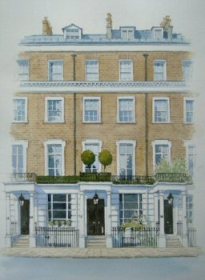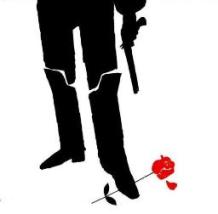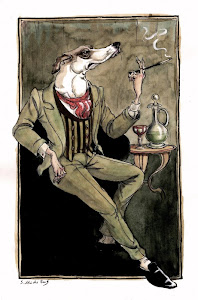30 December 2011
28 December 2011
27 December 2011
Dispassion
 "The special trait making me an Anarch is that I live in a world which I ultimately do not take seriously. This increases my freedom; I serve as a temporary volunteer."
"The special trait making me an Anarch is that I live in a world which I ultimately do not take seriously. This increases my freedom; I serve as a temporary volunteer." Ernst Jünger, Eumeswil (1977)
Labels:
Jünger
26 December 2011
25 December 2011
23 December 2011
22 December 2011
21 December 2011
20 December 2011
On mens sana in corpore sano
 Recent successes at the office and in the bedroom have encouraged me to approach the training regimen with renewed dedication. To prepare for the impending conflicts, I follow a strict cardio and weight-training programme at least five mornings a week. Physical training is not only important for fitness, but also for looking good.
Recent successes at the office and in the bedroom have encouraged me to approach the training regimen with renewed dedication. To prepare for the impending conflicts, I follow a strict cardio and weight-training programme at least five mornings a week. Physical training is not only important for fitness, but also for looking good. You might be surprised to learn I have also signed up for 'Spinning' class. It surprised me, too, as it wasn't my choice. Spinning, as you know, is sort of like cycling in place; it works the lower and upper body. Participants are encouraged to move around in unison, as if dancing atop their machine. At this stage I am more concerned with completing the session in one piece than with executing the correct dance moves. And anyway, I find most modern dance vulgar. It never ceases to interest me that the highest art form (Music) should inevitably be accompanied by the lowest (Dance).
The sight of a dozen tight female behinds bobbing up and down in front of me would, under different circumstances, provoke in me thoughts of a most roguish nature. But, again, my mind is focused on more existential matters. I simply want to survive, at least until the end of class. After three Spinning sessions I feel as if my bulging, muscular thighs have been whipped by hot chains and my backside violated by a spiked cricket bat. Not good. But, as they say, what doesn't kill me only makes me stronger. And so it shall.
The renewed focus on fitness extends to diet. As you know, I follow a Paleo-like diet consisting of meat, eggs, green vegetables, nuts, and lots of tea. Supplemented, of course, by wine, whisky, gin, and occasional cheeseburgers. I avoid fast food. If you insist on asking me to eat a carton of Chicken McNuggets, I'll punch you in the face. I haven't had a Coke or Pepsi since the early 1990s, and no carbonated soft drinks of any kind for over 10 years. I lack a sweet tooth. In fact I detest candy. I view sugar, carbs, processed foods, and baked goods the same way I view American society: empty, destructive, useless, devoid of value.
And there's the connection. The revolt against modernity involves not only right-thinking, but also right-living. The lies I woke up to in my 20s were the lies concerning women, race, judaics, history, economics, etc., that the liberal-totalitarian Establishment shoves down our throat. But awakening also forces a reappraisal of one's manner of living, and, if need be, a general rejection of modern American consumer culture in all of its manifestations. And that includes adopting the right fitness training regimen and diet. Don't be afraid to become who you are. Live your resistance.
Labels:
Admiral Cod,
Training
19 December 2011
18 December 2011
16 December 2011
14 December 2011
Sherlock Holmes: Fierce Energy
 'My own complete happiness, and the home-centred interests which rise up around the man who first finds himself master of his own establishment, were sufficient to absorb all my attention, while Holmes, who loathed every form of society with his whole Bohemian soul, remained in our lodgings in Baker Street, buried among his old books, and alternating from week to week between cocaine and ambition, the drowsiness [sic] of the drug, and the fierce energy of his own keen nature.'
'My own complete happiness, and the home-centred interests which rise up around the man who first finds himself master of his own establishment, were sufficient to absorb all my attention, while Holmes, who loathed every form of society with his whole Bohemian soul, remained in our lodgings in Baker Street, buried among his old books, and alternating from week to week between cocaine and ambition, the drowsiness [sic] of the drug, and the fierce energy of his own keen nature.'"A Scandal in Bohemia", Arthur Conan Doyle (1891)
Steampunk !
 After a morning of intense weight-training, I picked her up to attend a local museum to view a Victorian art show and Steampunk exhibition. It was her idea. The Victorian art was sublime, as always, and included a prized Burne-Jones piece and several hunting scenes. The Steampunk show was another matter. Steampunk, as Wikipedia defines it:
After a morning of intense weight-training, I picked her up to attend a local museum to view a Victorian art show and Steampunk exhibition. It was her idea. The Victorian art was sublime, as always, and included a prized Burne-Jones piece and several hunting scenes. The Steampunk show was another matter. Steampunk, as Wikipedia defines it:'...is a sub-genre of science fiction, fantasy, alternate history, and speculative fiction that came into prominence during the 1980s and early 1990s. Steampunk involves a setting where steam power is still widely used—usually Victorian era Britain or "Wild West"-era United States—that incorporates elements of either science fiction or fantasy. Works of steampunk often feature anachronistic technology or futuristic innovations as Victorians may have envisioned them, based on a Victorian perspective on fashion, culture, architectural style, art, etc. This technology includes such fictional machines as those found in the works of H. G. Wells and Jules Verne...'
So there you have it. Most of the artifacts and clothing involve configurations of leather, metal, and imagined sci-fi contraptions. Steampunk, while on the surface rather silly, is precisely the sort of sub-culture or alternative community our people must construct as a balwark against the State-sponsored popular culture. My particular favourite was the Jules Verne exhibit, featuring the novel 20,000 Leagues Under the Sea and a model of the submarine Nautilus, with which I was fascinated as a small child. Captain Nemo was an early inspiration.
Afterwards we stopped by the German Club for a late lunch.
13 December 2011
12 December 2011
Oysters Tsarina
There was a time not too long ago, as you know, when I enjoyed oysters and champagne almost every evening. A couple of bottles of Veuve Clicquot and two dozen raw oysters on the half-shell with bank colleagues after work. It is only recently that I revived the practice, though on a slightly different scale. I read an interview with Barry Humphries in the FT over the weekend in which he mentions a dish called Oysters Tsarina (excerpt below). I am unfamiliar with it, but it sounds très delish. If you have the precise recipe, please do pass it along.
'He talks about an interview he did many years ago with a newspaper at the Savoy Hotel. “I could order whatever I wanted. So I ordered Oysters Tsarina. Oysters that you dip in sour cream, chopped onions and caviar. You slurp those down. And the chef came out, quite an elderly man, and he said, “I just wanted to say you’re the first person to have ordered Oysters Tsarina since von Ribbentrop.” He beams at this outrageous association with the Nazi foreign minister. Humphries is a connoisseur of provocation.'
'Lunch with the FT: Barry Humphries', Financial Times, 9 December 2011
'He talks about an interview he did many years ago with a newspaper at the Savoy Hotel. “I could order whatever I wanted. So I ordered Oysters Tsarina. Oysters that you dip in sour cream, chopped onions and caviar. You slurp those down. And the chef came out, quite an elderly man, and he said, “I just wanted to say you’re the first person to have ordered Oysters Tsarina since von Ribbentrop.” He beams at this outrageous association with the Nazi foreign minister. Humphries is a connoisseur of provocation.'
'Lunch with the FT: Barry Humphries', Financial Times, 9 December 2011
Living Dangerously (Ranulph Fiennes)
 'First published in 1987, this book takes Ranulph Fiennes from his South African boyhood and army career to the series of breathtaking expeditions which have justly earned him the title of "the world's greatest living explorer". Since then, however, his determination to seek new challenges and, more importantly, to conquer them has led him to attempt to reach the North Pole without dogs or motorized equipment, to find the lost city of Ubar, hidden in the Arabian desert, and most recently, his extraordinary journey across the Antarctic to the South Pole. Writing with honesty and good humour, Ranulph Fiennes gives us a taste of the excitement, the hardship, the vital teamwork and the sheer courage that is the life of the modern explorer. He is an English hero in the classic mould - a man of whom it can be said that he has been everywhere and done everything.'
'First published in 1987, this book takes Ranulph Fiennes from his South African boyhood and army career to the series of breathtaking expeditions which have justly earned him the title of "the world's greatest living explorer". Since then, however, his determination to seek new challenges and, more importantly, to conquer them has led him to attempt to reach the North Pole without dogs or motorized equipment, to find the lost city of Ubar, hidden in the Arabian desert, and most recently, his extraordinary journey across the Antarctic to the South Pole. Writing with honesty and good humour, Ranulph Fiennes gives us a taste of the excitement, the hardship, the vital teamwork and the sheer courage that is the life of the modern explorer. He is an English hero in the classic mould - a man of whom it can be said that he has been everywhere and done everything.'
09 December 2011
08 December 2011
07 December 2011
06 December 2011
05 December 2011
04 December 2011
Fortnum & Mason Christmas Hamper
 There was a piece in The Daily Telegraph on that great holiday tradition, the Christmas hamper. Here is an excerpt:
There was a piece in The Daily Telegraph on that great holiday tradition, the Christmas hamper. Here is an excerpt:"For a great many people, a Fortnum’s hamper represents the very epitome of a traditional Christmas, or at least as dreamt up by Dickens – himself a loyal Fortnum’s customer.
And in truth, could there be anything more thrillingly festive than the first sighting of a distinctive F&M logo’ed wicker basket sitting plumply on a doorstep (hopefully your own)? Nestling inside is the flavoursome promise of gastronomic fare fit for a king, or a caliph.
With the coming of the Romantic Movement, the vogue for eating outdoors and enjoying the countryside led to the popularity of Fortnum’s hampers. As The Season became established, the well-to-do were sustained at the Eton-Harrow cricket match at Lord’s, Henley Royal Regatta, Ascot and so forth by jugged hare and truffles.
Hampers, or rather tea chests, were also dispatched to officers fighting the Naopleonic Wars, and in the 1850s, Queen Victoria ordered the store to send Florence Nightingale an enormous consignment of concentrated beef tea for the wounded in the Crimea.
“Earl Haig requested bespoke hampers, designed like panniers, to straddle a camel and, of course, Fortnum’s obliged,” says Tanner. “There was a dedicated officers’ supply department, set up in 1914 to provide food parcels for the Western Front, Gallipoli, Russia and North Africa. Winston Churchill complained bitterly by letter when his wife Clemmie sent him upmarket provisions because what he really desperately wanted was a hot-water bottle.”
It was after the Great War that Christmas hampers really took off as fewer people were inclined to make their own Christmas cakes and puddings."
03 December 2011
01 December 2011
Subscribe to:
Comments (Atom)





















































